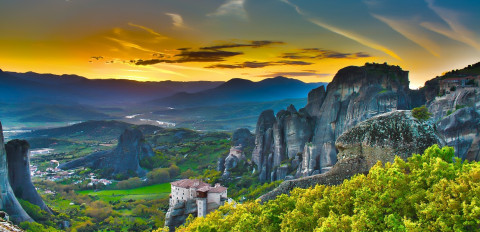Any visitor who has ever set foot in the valley of Meteora can attest to its unique natural beauty. The overwhelming sense of awe at first glance only magnifies as you closely observe the gigantic rock pillars innocuously rising from the plateau. Alas, it is the human touch that completes this portrait, with the Byzantine Monasteries that rest on top of the pillars.
Something about the area seems to welcome asceticism. The first recorded group to inhabit Meteora in modern history were hermit monks sometime in 9th the century AD. Living in hollows and fissures on the pillars, the hermits often chose the location of their dwellings in order to deter visitors and retain their self-imposed isolation. In their early days in the valley, they led a life of solitude, meeting only on Sundays and major holidays to worship and pray. On those special days, at the foot of the rock Dhoupiani, the hermits would gather in a chapel that they had built themselves.
Although the exact date of the establishment of the monasteries is unknown, by the end of the 12th century, an entire ascetic community had flocked to Meteora. Around a century before that, the Skete of Stagoi, a rudimentary monastic state centered around the church of Theotokos, had paved the way for this spiritual bloom. Meteora was already starting to look like the iconic landscape that we have come to know today.
 The first of the 24 Byzantine Monasteries to be founded was the great Meteoron Monastery, translating to ‘suspended in the air’. Built in the sunset of the 14th century on the Broad Rock, the monastery created a haven for monks as it protected them from the political upheaval of the era and gave them complete control of access. The only means of reaching the entrance was by climbing a long ladder, which was drawn up whenever the monks felt threatened. With the Byzantine Empire’s hold over Northern Greece in a precarious state and Turkish raiders eyeing the fertile plains of Thessaly, the monks of Meteora looked for a secure way to continue their ascetic life. The pillars were to provide ideal refuge during these dangerous times, as more followed the example of Meteoron Monastery and built 23 more houses of worship in the same fashion over the coming years.
The first of the 24 Byzantine Monasteries to be founded was the great Meteoron Monastery, translating to ‘suspended in the air’. Built in the sunset of the 14th century on the Broad Rock, the monastery created a haven for monks as it protected them from the political upheaval of the era and gave them complete control of access. The only means of reaching the entrance was by climbing a long ladder, which was drawn up whenever the monks felt threatened. With the Byzantine Empire’s hold over Northern Greece in a precarious state and Turkish raiders eyeing the fertile plains of Thessaly, the monks of Meteora looked for a secure way to continue their ascetic life. The pillars were to provide ideal refuge during these dangerous times, as more followed the example of Meteoron Monastery and built 23 more houses of worship in the same fashion over the coming years.
Life was hard in Meteora, but the monks preferred it that way. Access to the monasteries was deliberately difficult, requiring either long ladders latched together or large nets used to haul up both goods and people. Folk stories from Thessaly claim that the ropes would only be replaces after they broke, or as the monks put it, ‘only when the Lord lets them break’. This meant that simply entering or leaving the monasteries required a huge amount of faith.
For more than 400 years, life went on in this way in Meteora. Political turmoil, from the occupation by Ottoman Empire, the subsequent Greek War of Independence and the chaos that surrounded the newfound Greek state, did not disrupt the monks’ pious, traditional way of life. The final change to the valley, that brought it to the shape we have come to know today, came in the 1920s. Steps were carved into the rock and connected the complex with a nearby plateau via a bridge. Meteora was still a recluse, but was no longer cut off from the rest of the world.
Although the hardships would continue in WWII with the site bombed and art treasures stolen by the Axis forces, nothing could bend the tranquil determination of the inhabitants. Now a UNESCO World Heritage Site and with a quarter of the original monasteries still open, the handful of monks in Meteora have opened their hearts and their homes to the pilgrims who come every year to admire the landscape, learn about its history and partake in their lifelong spiritual journey.
Experience true harmony of spirit in Meteora with our offers below.
 |
 |
 |
| In the footsteps of Saint Paul | Journey To The Oracle of Delphi, Majestic Meteora and The Greek Islands | Private Full Day Trip to Meteora |

